The Crucial MX300 750GB SSD Review: Micron's 3D NAND Arrives
by Billy Tallis on June 14, 2016 9:00 AM ESTSequential Read Performance
The sequential read test requests 128kB blocks and tests queue depths ranging from 1 to 32. The queue depth is doubled every three minutes, for a total test duration of 18 minutes. The test spans the entire drive, and the drive is filled before the test begins. The primary score we report is an average of performances at queue depths 1, 2 and 4, as client usage typically consists mostly of low queue depth operations.
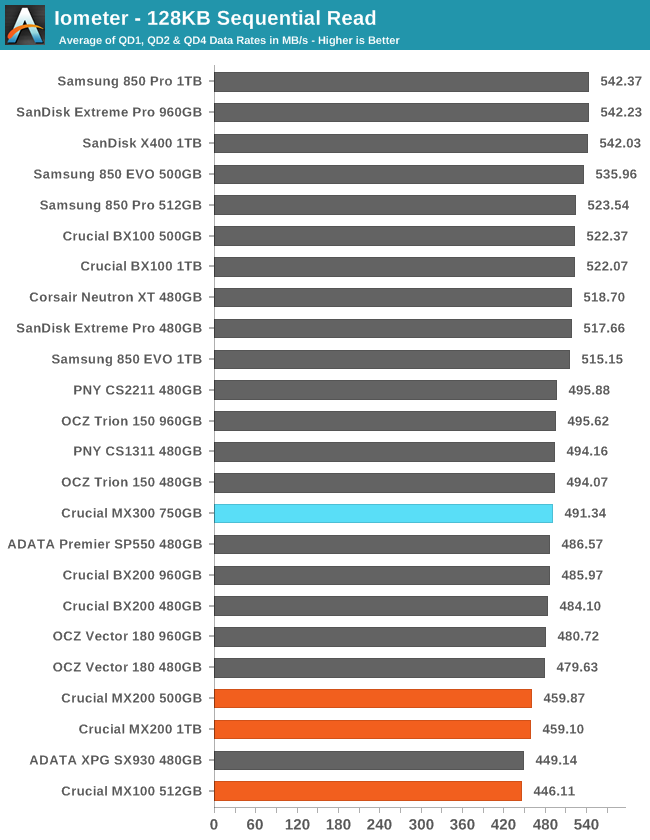
The earlier MX series drives had somewhat poor sequential read speeds, though the spread from best to worst is quite small. The MX300 brings things up to average.
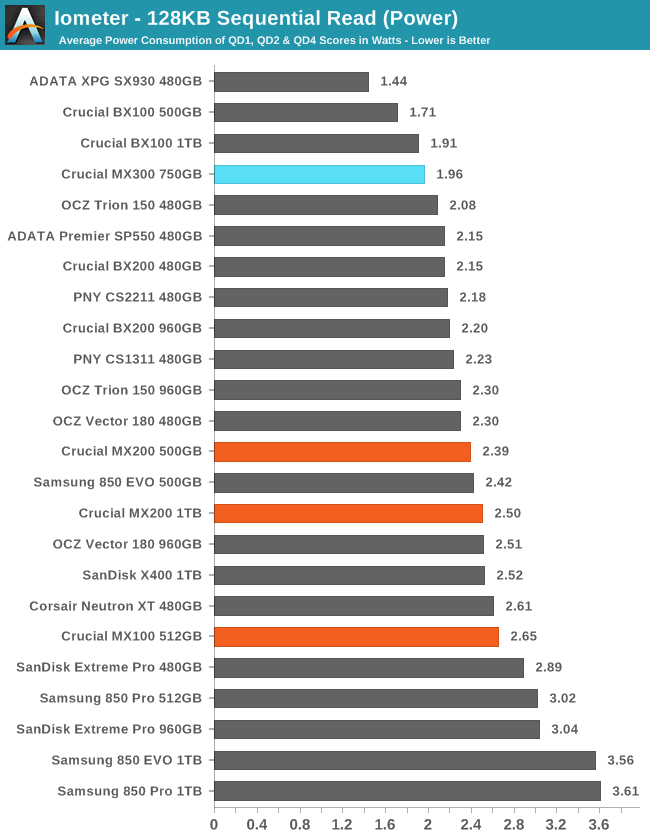
The MX300 is still quite efficient, but the SX930 and BX100 500GB both beat it by a wide margin.
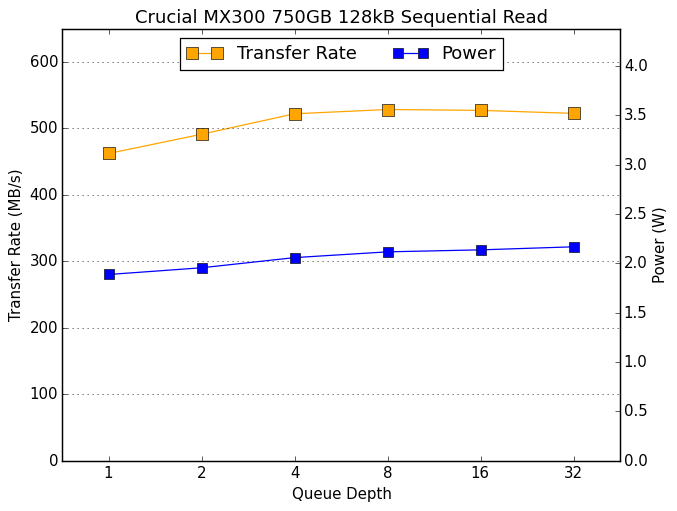 |
|||||||||
With a higher starting point, the MX300's performance scaling is not as pronounced as the MX200's. The MX300 is a little bit slower at higher queue depths.
Sequential Write Performance
The sequential write test writes 128kB blocks and tests queue depths ranging from 1 to 32. The queue depth is doubled every three minutes, for a total test duration of 18 minutes. The test spans the entire drive, and the drive is filled before the test begins. The primary score we report is an average of performances at queue depths 1, 2 and 4, as client usage typically consists mostly of low queue depth operations.

Sequential write speeds on the MX300 are much slower than the MX200 or any other MLC drive, but it does manage to come out ahead of all the planar TLC drives.
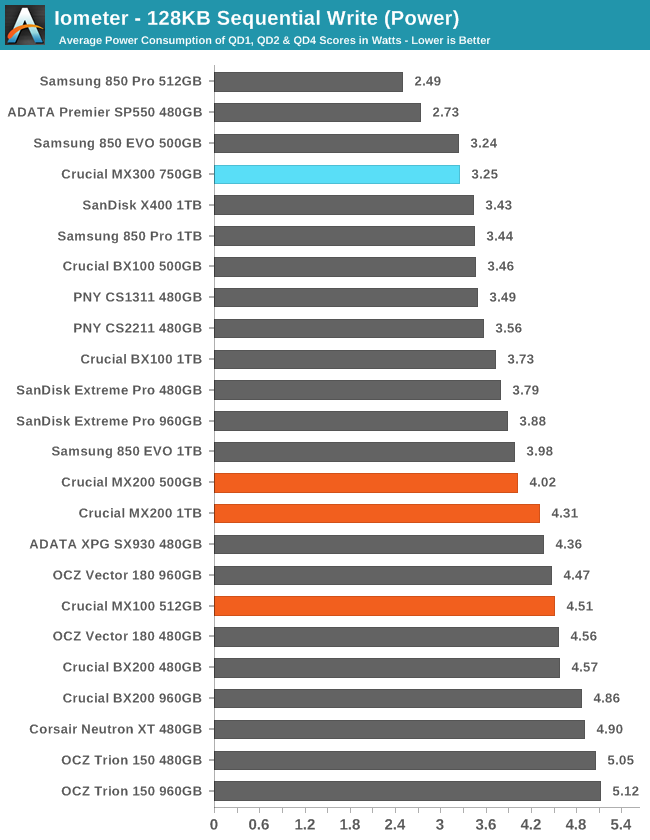
Power efficiency is still great by planar TLC standards, but the Samsung 850 EVO managed to saturate the SATA connection while using the same amount of power.
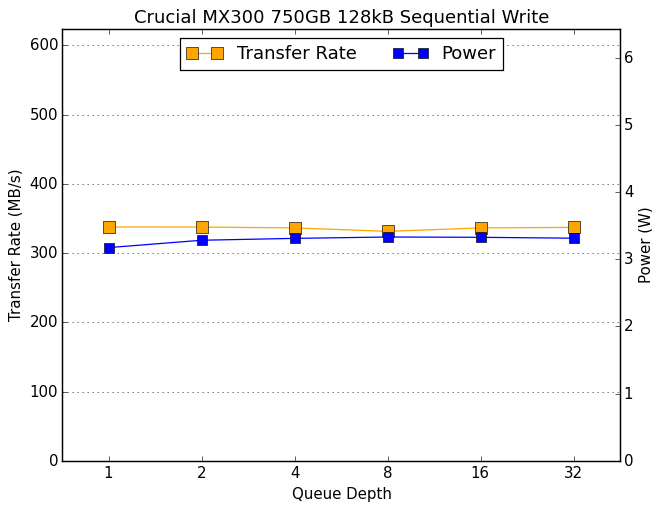 |
|||||||||
The MX300 shows essentially no scaling with queue depth. For this test we usually don't see much scaling as caching large writes allows for full performance even at low queue depths, but full performance for the MX300 is still disappointing.










85 Comments
View All Comments
Gondalf - Wednesday, June 15, 2016 - link
Good point. The real story the have not even read the article, or maybe there is a lot of marketing guys at work here.After all Samsung has shipped for two years 3D SSD drivers in nearly money loss cause the low yields of their manufacturing process on a 3D structure.
icrf - Tuesday, June 14, 2016 - link
What is the expected performance of the 3D MLC NVMe SSD, or is that too many variables different to tell from here? I'm curious if the charge trap/floating gate decision affected performance.jabber - Tuesday, June 14, 2016 - link
I'm taking it that Crucial have given up on SSD R&D? After all each Crucial SSD post BX100 (what a great SSD) just gets slower than the previous.JoeyJoJo123 - Tuesday, June 14, 2016 - link
If Crucial has "given up" then what does that speak for Toshiba and other manufacturers that STILL haven't done 3D stacked MLC NAND?Samsung led the innovation 2 years ago and now their first competitor just showed up.
vladx - Tuesday, June 14, 2016 - link
Sandisk X400 seems to be the king of budget SSDs, paying 80USD more for 850 EVO is definitely not worth it imo.Meteor2 - Tuesday, June 14, 2016 - link
Can't dispute that.Lolimaster - Saturday, June 18, 2016 - link
They're not.Unless you move tons of data per day with more than 1 pci-e nvme drive there's no difference between sata and pcie ssd's. PCie ssd uses more power and produces more heat.
Communism - Tuesday, June 14, 2016 - link
With the advent of PCIE 3.0 X4 NAND drives a while ago, the whole SATAIII segment of SSDs are essentially obsolete. The lack of significant competition in the PCIE3.0 X4 NAND drives bringing down prices quickly is disconcerting.The only COGS difference between PCIE3.0 X4 NAND drives and SATAIII drives is the controller, which doesn't actually cost much at all.
Buying into SATAIII SSDs at this point in time simply is a bad idea comparatively.
TheinsanegamerN - Tuesday, June 14, 2016 - link
Sara is hardly obsolete. Pcie m2 drives still only hit 512gb vs the 2tb sata drives, still run hotter, and don't offer much but a faster boot time. Day to day performance between sata and pice is nil unless you are moving hundreds of gigs of data per day onto/off of the drive.Until m.2 is cheaper, cooler, and the same capacity as sata, sata isn't going anywhere.
vladx - Tuesday, June 14, 2016 - link
Actually, NVMe drives boot slower because of additional drivers needed to be loaded.